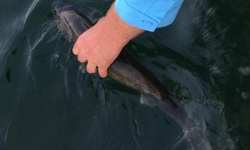PITTSBURGH — Every year, Pennsylvania stocks its public waterways with millions of trout in the hopes that humans will follow.
Judging from the numbers who turn out religiously for the opening day of trout season, the strategy is working. On opening day for the 2019 season, anglers were back – stalking brook, rainbow and brown trout, among other species.
But the number of fishing licenses and trout/salmon permits being sold tells a different, more complicated story.
Pennsylvania fishing license sales are down, and the state is trying to improve participation by focusing on water quality and nontraditional fishermen.
“The peak of fishing license sales occurred in 1990. It’s been consistently even or down since then,” said Michael Parker, spokesman for the state Fish and Boat Commission. “We’re seeing a slight trend upward (from 2018). We’re hoping to see some momentum back toward the sport. We’re optimistic that we’re making a good case for it.”
In 1990, the state sold just over a million resident fishing licenses. Trout/salmon permit sales started in 1991 and now typically accompany about 70 percent of fishing licenses sold, Parker said.
“Seven out of 10 fishermen also purchase a trout and salmon stamp,” he said.
In 2018, by comparison, the state sold 617,816 resident licenses – the fewest since 1968 – and 440,717 trout/salmon permits, which are required for trout season. Trout/salmon permit sales peaked in 1995 at 760,590, according to the Fish and Boat Commission.
Reasons for the decline in both are complex and not easy to trace. The state, however, is trying to counteract them, Parker said.
“While outdoor recreation is still popular with families, there are many more options that compete with fishing, including a youth sports schedule that is more demanding than it was on previous generations,” Parker said.
Children don’t default to fishing like they used to, and adults aren’t as likely to teach them how to fish, said Annie Quinn, executive director of the Jacobs Creek Watershed Association.
“I wasn’t born a fisherman – I had to be taught to fish,” Quinn said. “Fishing is a hard sport to get someone to do. You have to sit still for a long time, and that requires patience.”
More than 49 million Americans participated in recreational fishing in 2017, the latest figures available. The Outdoor Foundation and Recreational Boating & Fishing Foundation stated in its 2018 Special Report on Fishing, which is released annually, that the number of people who fished that year was the highest since 2009. Children ages 6 to 17 accounted for 11.6 million of those who fished that year – an increase of 700,000 from 2016.
If people don’t start to fish by age 12, it is much less likely they ever will, the Washington, D.C.-area organizations reported.
Hooking them young
Jacobs Creek Watershed Association was among the many organizations that participated in this year’s Mentored Youth Trout Day on April 6. About 70 children, more than half of whom were girls, participated in the event at the Bridgeport Dam in Mt. Pleasant Township, she said.
In preparation, the association partnered with a local Trout Unlimited chapter and the Fish and Boat Commission to stock 600 trout – 300 more than usual – in the Whites Bridge area.
Quinn said Mentored Youth Trout Day, although not a popular idea with all fishermen, is one way to safeguard the sport for the future.
“I would say it’s an example of the Fish and Boat Commission making an unpopular decision to go toward a nontraditional population and to attract women and children fishermen. I do think it will make a lasting change and a significant impact,” Quinn said.
Parker said the state is using programs such as the youth trout day and its Gaun First Catch Center program in Philadelphia to address the decline in fishing.
“While many of these programs are only a few years old, we believe they are having an impact and that they will eventually translate to a love of fishing and, ultimately, more license sales,” he said.
Multi-year licenses, which were introduced in 2013, also are a factor because they complicate year-to-year sales comparisons, Parker said. In any given year, the state has to account for those anglers who are already in the system under active multi-year licenses, he said.
License sales are important for another reason – they constitute nearly half of the Fish and Boat Commission’s $54.3 million annual budget, according to commission figures.
Cleaning up
When it comes to water quality, fishing is benefiting from generally cleaner streams, experts say.
While streams linked to active watershed associations are improving, the perception in Western Pennsylvania is that they still suffer from a history of industrial pollution, Quinn said. Older generations can’t remember a time when the water was clean, especially the Allegheny and Monongahela rivers.
“Your average opinion is that the water is disgusting,” she said. “I think there’s definitely a perception issue, and I do not think the (improved) quality of the rivers has reached public opinion.”
The decline in fishing license sales has nothing to do with water quality because water quality is improving, said Steve Hegedus, president of the Tri-County Trout Club. The club is based in Lower Burrell but has members from Westmoreland, Allegheny and Armstrong counties.
“If you go back to the Clean Water Act (of 1972), a lot of streams have been cleaned up. A lot more people fish in the river than used to,” Hegedus said.
Social factors are more at fault, he said. Children don’t fish like they used to because there are more things for them to do, and they tend to stay indoors more.
Organizations like the Tri-County Trout Club try to combat that trend by hosting fishing days, fishing prizes and fishing equipment giveaways for children. Those who fish when they are young are more likely to become adult anglers, he said.
“The main thing is to get them out and fishing,” he said. “You’ve got to start early if you want to keep these (sales) numbers up.”






